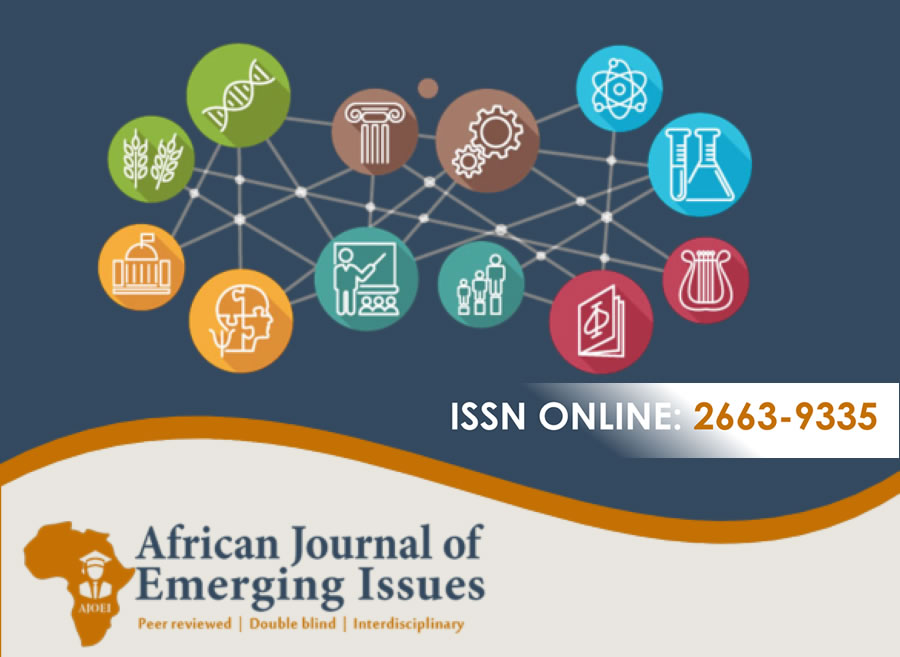CONCEPTUALIZING, DEFINING CHILDREN WITH AUTISM IN KENYA: STAKEHOLDER PERSPECTIVES INVESTIGATING STRATEGIES TO PROMOTE AND SUPPORT CHILDREN WITH AUTISM BETWEEN 0-3 YEARS
Abstract
Purpose: This study developed a conceptual framework addressing the gap in autism research in low- and middle-income countries, particularly Kenya.
Statement of the Problem: In Kenya, autism research faced significant challenges as research was heavily concentrated in wealthy Western nations, while these regions lacked culturally appropriate screening and diagnostic tools for autism.
Research Methodology: The study employed a multidisciplinary review approach combining analysis of autism research literature with works on mental health, cultural psychiatry, cross-cultural psychology, and intellectual disability research.
Findings: The framework took into account four interconnected levels: expression, recognition, interpretation, and reporting of autism symptoms, describing cultural and contextual factors associated with each level.
Conclusion: The framework aided development of culturally appropriate autism screening tools and cross-cultural research directions by outlining cultural factors affecting ASD identification and diagnosis.
Recommendations: The concept is pertinent to Kenyan physicians and decision-makers seeking to enhance support for marginalized autism populations through culturally informed approaches.
Keywords: Conceptualizing, Defining Children, Autism, Stakeholder Perspectives, Strategies, Promote and Support Children, 0-3 Years
References
Abubakar, A., Ssewanyana, D., de Vries, P. J., & Newton, C. R. (2016). Autism spectrum disorders in sub-Saharan Africa. The Lancet Psychiatry, 3(9), 800–802.
Al Maskari, T. S., Melville, C. A., & Willis, D. S. (2018). Systematic review: Cultural adaptation and feasibility of screening for autism in non-English speaking countries. International Journal of Mental Health Systems, 12, 22. https://doi.org/10.1186/s13033-018-0200-8
American Psychiatric Association. (2013). Diagnostic and Statistical Manual of Mental Disorders (DSM-5)
Baghdadli, A., Picot, M. C., Pascal, C., Pry, R., & Aussilloux, C. (2003). Relationship between age of recognition of first disturbances and severity in young children with autism. European Child & Adolescent Psychiatry, 12(3), 122–127. https://doi.org/10.1007/s00787-003-0314-6
Bakare, M. O., & Munir, K. M. (2011). Excess of non-verbal cases of autism spectrum disorders presenting to orthodox clinical practice in Africa A trend possibly resulting from late diagnosis and intervention. The South African Journal of Psychiatry: SAJP: The Journal of the Society of Psychiatrists of South Africa, 17(4), 118–120.
Cauce, A. M., Domenech-Rodríguez, M., Paradise, M., Cochran, B. N., Shea, J. M., Srebnik, D., & Baydar, N. (2002). Cultural and contextual influences in mental health help seeking: A focus on ethnic minority youth. Journal of Consulting and Clinical Psychology, 70(1), 44–55.
Daley, T. C. (2004). From symptom recognition to diagnosis: Children with autism in urban India. Social Science & Medicine, 58(7), 1323–1335.
Daley, T. C., Singhal, N., & Krishnamurthy, V. (2013). Ethical considerations in conducting research on autism spectrum disorders in low- and middle-income countries. Journal of Autism and Developmental Disorders, 43(9), 2002–2014. https://doi.org/10.1007/s10803-012-1750-2
De Vries, P.J. (2016). Thinking globally to meet local needs. Current Opinion Neurology, 29(0).
Freeth, M., Sheppard, E., Ramachandran, R., & Milne, E. (2013). A cross-cultural comparison of autistic traits in the UK, India and Malaysia. Journal of Autism and Developmental Disorders, 43(11), 2569–2583. https://doi.org/10.1007/s10803-013-1808-9
Greenhalgh, T., & Peacock, R. (2005). Effectiveness and efficiency of search methods in systematic reviews of complex evidence: Audit of primary sources. BMJ (Clinical Research Ed.), 331(7524), 1064–1065. https://doi.org/10.1136/bmj.38636.593461.68
Grinker, R. R., Chambers, N., Njongwe, N., Lagman, A., Guthrie, Stronach, … Wetherby. (2012). “Communities” in Community Engagement: Lessons Learned from Autism Research in South Korea and South Africa. Autism Research, 5(3), 201–210. https://doi.org/10.1002/aur.1229
Jacobs, B., Ir, P., Bigdeli, M., Annear, P. L., & Van Damme, W. (2012). Addressing access barriers to health services: An analytical framework for selecting appropriate interventions in low-income Asian countries. Health Policy and Planning, 27(4), 288–300. https://doi.org/10.1093/heapol/czr038
Kakooza-Mwesige, A., Ssebyala, K., Karamagi, C., Kiguli, S., & et. al. (2014). Adaptation of the “ten questions” to screen for autism and other neurodevelopmental disorders in Uganda. Autism, 18(4), 447–457.
Kamio, Y., Inada, N., Koyama, T., Inokuchi, E., Tsuchiya, K., & Kuroda, M. (2014). Effectiveness of Using the Modified Checklist for Autism in Toddlers in Two-Stage Screening of Autism Spectrum Disorder at the 18-Month Health Check-Up in Japan. Journal of Autism and Developmental Disorders, 44(1), 194–203. https://doi.org/10.1007/s10803-013-1864-1
Khowaja, M. K., Hazzard, A. P., & Robins, D. L. (2015). Sociodemographic Barriers to Early Detection of Autism: Screening and Evaluation Using the M-CHAT, M-CHAT-R, and Follow-Up. Journal of Autism and Developmental Disorders, 45(6), 1797–1808. https://doi.org/10.1007/s10803-014-2339-8].
Kleinman, A. (1987). Anthropology and psychiatry. The role of culture in cross-cultural research on illness. The British Journal of Psychiatry: The Journal of Mental Science, 151, 447–454.
Lai, M.-C., Lombardo, M. V., Auyeung, B., Chakrabarti, B., & Baron-Cohen, S. (2015). Sex/gender differences and autism: Setting the scene for future research. Journal of the American Academy of Child and Adolescent Psychiatry, 54(1), 11–24. https://doi.org/10.1016/j.jaac.2014.10.003
Munir, K., Lavelle, T. A., Helm, D. T., Thompson, D., Prestt, J., & Azeem, M. W. (n.d.). Autism: A global framework for action. Report of the WISH Autism Forum 2016.
Perera, H., Wijewardena, K., & Aluthwelage, R. (2009). Screening of 18-24-month-old children for autism in a semi-urban community in Sri Lanka. Journal of Tropical Pediatrics, 55(6), 402–405. https://doi.org/10.1093/tropej/fmp031
Rice, C. E., & Lee, L.-C. (2017). Expanding the global reach of research in autism. Autism: The International Journal of Research and Practice, 21(5), 515–517. https://doi.org/10.1177/1362361317704603
Rogler, L. H. (1993). Culturally sensitizing psychiatric diagnosis. A framework for research. The Journal of Nervous and Mental Disease, 181(7), 401–408.
Soto, S., Linas, K., Jacobstein, D., Biel, M., Migdal, T., & Anthony, B. J. (2015). A review of cultural adaptations of screening tools for autism spectrum disorders. Autism: The International Journal of Research and Practice, 19(6), 646–661. https://doi.org/10.1177/1362361314541012
WHO. (2012). Developmental difficulties in early childhood: Prevention, early identification, assessment and intervention in low- and middle-income countries: a review. Geneva, Switzerland: World Health Organization.
WHO. (2018, June). ICD-11 International Classification of Diseases for Mortality and Morbidity Statistics, Eleventh Revision.
World Health Organization. (2012). Developmental difficulties in early childhood: Prevention, early identification, assessment and intervention in low- and middle-income countries: a review. Geneva, Switzerland: World Health Organization.
World Health Organization. (2018). ICD-11 International Classification of Diseases for Mortality and Morbidity Statistics, Eleventh Revision.





